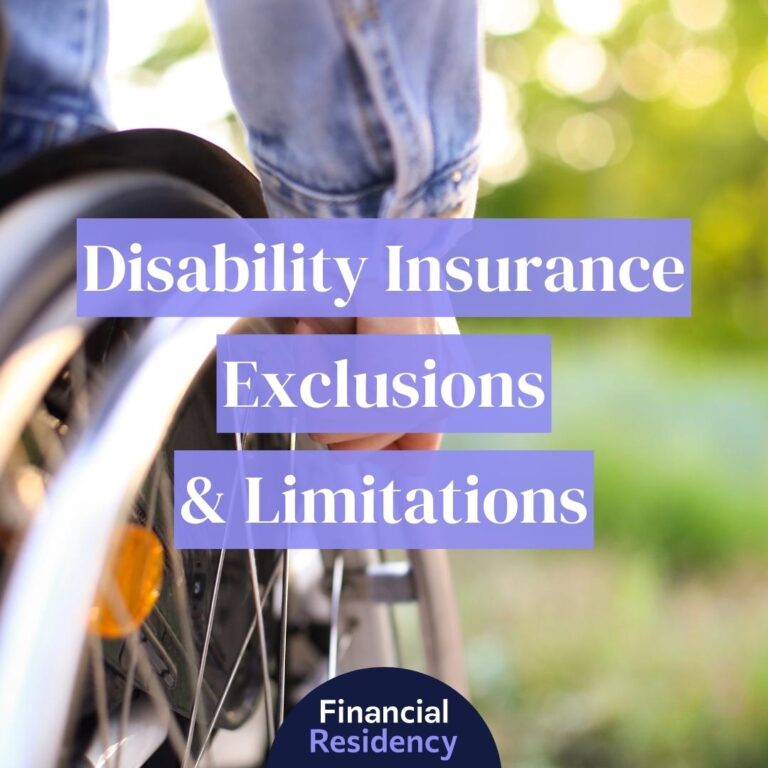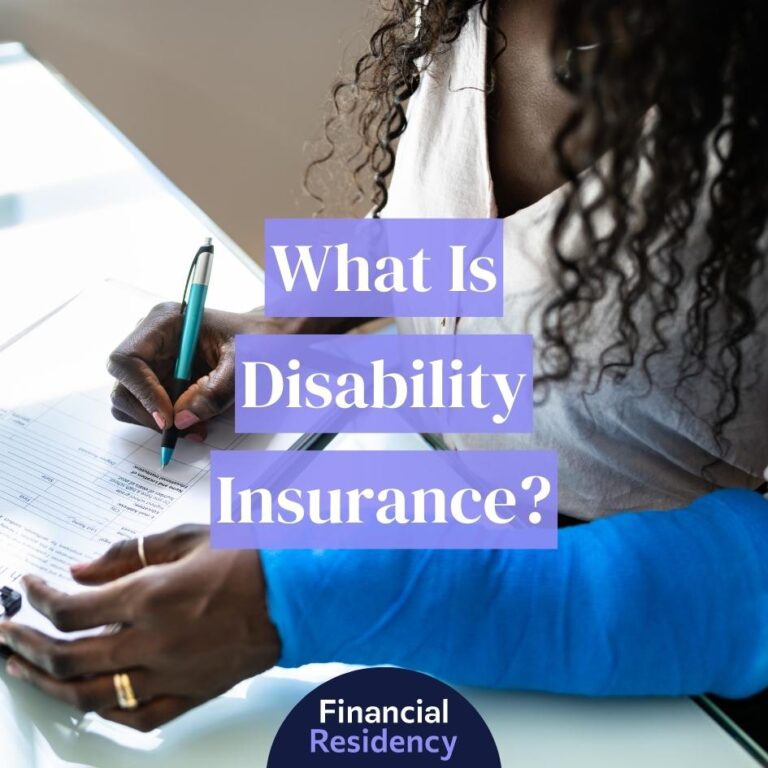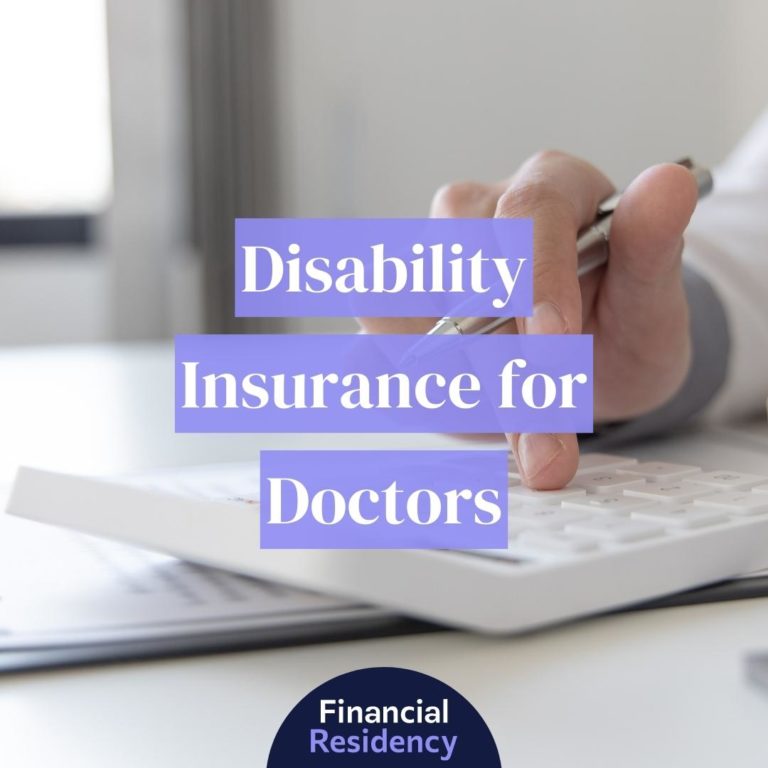Protecting your income starts in residency. You might not think of disability insurance for residents, but it should be a top priority.
After going through med school, the last thing you need is to end up disabled and have no income.
That would be devastating for your mind, family, and future life. To protect your family financially, disability insurance for residents is highly recommended.
Here’s what you should know.
What Is Disability Insurance for Residents?
Disability insurance income protects your future income if you cannot work due to injury or illness.
It won’t cover 100% of your lost income, but it provides a percentage to help you handle life’s expenses while unable to work. Most policies provide up to 60% of your pre-disability income.
Now that you’re a resident and making an income, you must protect it. You’ve likely spent hundreds of thousands of dollars to start your career, and anything can happen. Becoming disabled could end your career and the financial plans you’ve worked hard to create.
You might think you’re young and invincible, but 25% of people in their 20s become disabled before retirement, and your group policy likely won’t be enough to protect you financially if your employer even offers one.
Coverage
Disability income replaces a percentage of your income if you become ill or disabled under a covered occurrence. Each insurance company has different definitions of disability; most cover up to 60% of your lost income.
Each policy has different terms. Some will cover you for a specific number of years and others until you hit retirement age. Some policies also cover residual benefits, allowing you a lower percentage of benefits while you try to return to work, if possible. Others provide all or nothing.
Cost
Like any insurance policy, the cost varies based on many factors. The most significant factor is your age. The younger you are when you buy disability insurance, the lower the premiums you’ll pay. As you age, your premiums increase because your risk of illness and even injury increases.
Other factors affecting your disability insurance cost include:
- Specialty
- Gender
- Percentage of income you want to cover
- Coverage period
- Add-ons
- The insurance company you choose
Long vs. Short-Term Disability Insurance
When choosing disability insurance for residences, you have two options, short-term and long-term disability.
- Short-term disability covers an injury or illness that renders you disabled for up to one year. This is more common with group insurance policies, but individual insurance companies offer it too.
- Long-term disability covers illnesses or injuries that render you disabled for over one year. This may mean a couple of years until you can work again or long-term coverage until age 65 when you’re at ‘legal’ retirement age.
Own Occupation vs. Any Occupation Coverage
There are differences between own and any occupation coverage. For example, any occupation coverage may cost less but has more restrictions, making it harder to file a claim and get benefits.
- Own occupation coverage pays out if you are disabled and unable to work in the specialty you majored in during med school. The policy will continue to cover you even if you can work another job. For example, the insurance would cover the difference if your new one doesn’t pay as much.
- Any occupation coverage only pays out if you’re fully disabled and unable to work any job, including a lower-paying one. So this type of coverage usually isn’t recommended for residents unless it has its own occupation rider. The rider will increase the cost but protect you further.
Disability Insurance Plans
There are different disability insurance plans, each offering different coverage options.
Group disability insurance usually has the lowest value and should be a supplement, not your primary policy.
Group Coverage
Many residencies include group disability insurance. It covers everyone in the company eligible for it but usually offers much less coverage and stricter terms. Even if the policy is portable and offers its own occupation coverage, they typically provide much less coverage and have more stringent definitions of disability.
Always read the fine print regarding portability and own occupation coverage, too, as they typically aren’t the same as individual coverage options.
Associate Policy
Associate disability insurance is another form of group disability coverage. For example, if you belong to any professional association, they may provide a small policy that can supplement individual policies.
Individual Coverage
Individual disability insurance provides more portability and typically more coverage. You have more options for riders and terms and don’t have to worry if you change jobs.
Individual policies are long-term and last as long as you pay the premiums or until you age out of the policy.
It’s a good idea to get an individual policy when you’re young to lock in lower premiums and avoid getting lower coverage because of a group policy.
Purchase a policy before a group disability insurance policy kicks in, and you can use the group coverage to supplement your individual coverage.
8 Reasons to Invest in Disability Insurance as a Resident
You might ask yourself, is disability insurance worth it as a resident? After all, you’re starting your career and are getting on your feet.
However, there are eight great reasons you may want to reconsider.
1. It May Be Cheaper as a Resident
Most insurance policies base their premiums on risk. The older you get, the more your risk of experiencing a disability increases. If you purchase a policy as a resident, you’re likely much younger and can lock in more affordable premiums.
Residents may also get discounts because they are still residents and aren’t in their full-blown careers.
The premium you lock in during residency is your premium for the entire term as long as you keep up with your payments. Typically, waiting until you make more money and can afford disability insurance costs much more. Hence, it makes sense to budget for it during residency and save thousands of dollars over the policy’s life.
2. Low-Risk for Medical Conditions
When you’re in residency, you’re young and healthy. As a result, insurers assume you are less likely to come down with serious illnesses or issues that could increase your disability premiums or cause the insurance company to exclude the condition from your disability coverage.
The younger you are, the fewer restrictions you face to get covered. Then, if things happen as you get older, such as injury or illness, you have disability protection if you can’t work, or you don’t have to worry about the issue being excluded should it worsen in the future, making it impossible to work.
3. Protect Your Income
Anyone can become disabled, even young and healthy residents. Life happens when you least expect it. If you are the breadwinner or have significant debt, such as student loan debt, you need income protection. If you cannot work, it could harm your family’s economic status.
Having financial security can ensure you stay on track with your debts and can cover your cost of living.
4. Pay Back Student Loan Debt
Student loans don’t disappear, even if you don’t make your payments. For example, say you file for bankruptcy. In most cases, student loan debt doesn’t get discharged. So if you cannot work, how would you pay your debt?
Having disability insurance ensures you can cover debts, including non-student debt-related loans.
5. Protection After Residency
Residents have a certain cap for disability insurance based on the average income they earn. Most insurance companies cap them at $5,000 to $6,500 per month. But you’ll likely make more when you’re finished with your residency.
Rather than going through underwriting again, you can add a Future Increase Option Rider to your policy. This rider allows increased coverage without additional underwriting. This means you’ll have disability protection starting in your residency, and it can continue well beyond it into your more established years.
6. Potential Access to Multi-Life Discounts
When you’re in your residency, and if you work for a large medical institution, you may be eligible for multi-life discounts or unisex discounts, allowing you to get cheaper premiums and save money on coverage.
You may even be eligible for Guaranteed Stanard Issue Policies that don’t require medical underwriting, making it even easier to get approved.
7. Portability
Most residents move on to another practice after residency, making portability essential. For example, if you change jobs and have only group disability insurance that isn’t portable, you leave the job without any disability insurance.
This puts you at the mercy of the following job’s group disability insurance options or requires you to undergo more medical underwriting. In addition, you’ll be older at this point and may have had some health issues in the interim, making it more expensive to get disability insurance or even more challenging to get approved.
8. Larger Benefit to Income Ratio
Residency is the only time you can receive up to 100% of your income in disability coverage. Typically, insurance companies make it unattractive to make a disability claim because you only earn up to 60% of your income.
However, most policies offer up to $5,000 a month in residency, sometimes more. This may cover 100% of your income in residency.
Characteristics of a Quality Disability Insurance Policy
When choosing the right disability insurance policy during residency, you should understand the options available to determine which suits your needs the most.
COLA Rider
As we’ve all experienced recently, inflation decreases the dollar’s value. When the cost of living increases, your disability benefits won’t be worth as much because inflation deflates the dollar’s value.
The COLA (cost of living adjustment) Rider ensures your benefits keep pace with inflation if you’re disabled for over 12 months.
Own-Occupation
The own-occupation rider is the key to having disability protection. When you have this rider, you can file a claim if you’re disabled and unable to perform your occupation. It doesn’t consider any other occupation.
For example, if you’re a specialized surgeon and lose the use of your arm, you can’t practice as a surgeon any longer. While there are other jobs you can do, they are likely lower paying and won’t provide the same income level. The own occupation rider protects your surgeon’s income, allowing you to work a lower-paying job and make an income.
Residual Disability Rider
If you can return to work but on a part-time basis or to a lower degree, earning you less money, the Residual Disability Rider will provide a proportionate amount of coverage to supplement your income loss.
To use your Residual Disability Rider, you typically have to have an income loss of at least 20%, but if you have a loss greater than 75%, you may be eligible for a total payout.
Long-Term
Opt for long-term coverage versus short-term. If you’re permanently disabled, you get coverage from the date of disability until retirement (65 years old) in most cases. On the other hand, short-term disability only covers disabilities of 12 months or less.
Long-term disability policies don’t kick in until you’re disabled for 12 months or longer, so a short-term policy can bridge the gap.
Future Increase
Always look for a future increase option when securing disability insurance during residency. For example, you can increase your coverage when you leave residency without going through medical underwriting again or paying higher premiums because you’re a few years older.
Student Loan Repayment Rider
Some policies offer a rider that pays off your student loans if you become disabled. Like any policy, there are limits, but the benefit is often for $150,000 to $250,000, depending on the insurance company.
Frequently Asked Questions
What Is a Policy Rider?
Policy riders provide additional coverage to the main policy. They usually have an additional cost but offer more protection. For example, the Future Increase Rider ensures you can increase coverage without undergoing additional underwriting. Of course, you’ll pay a higher premium for the rider, but when you make more money, you’ll appreciate it because you can increase your coverage.
What Is the Most Common Type of Disability Insurance for Residents?
Long-term disability insurance is the most common because it protects residents and doctors for the long term. If you have a short-term disability, you might have enough money in savings or be able to get by without insurance. But a long-term disability can be financially devastating to you and your family.
Learn More:
What Is the Most Common Type of Disability for a Resident?
Musculoskeletal disabilities are the most common type of disability for residents and doctors. Back pain and arthritis are the two most common complaints, with mental health disorders coming in a close second. The demanding nature of a resident’s job puts you at risk of overusing your body or suffering from anxiety, depression, and other mental health issues due to the job’s demands.
Should You Get Disability Insurance as a Resident?
Don’t overlook the importance of disability insurance for residents. You might think you’re too young to worry about it, but this is the best time to get it.
You’ll get lower premiums, protect your family from the unexpected, and be able to get future increases if you add the proper riders to your policy. It will be the most affordable now and will protect your family for many years.



